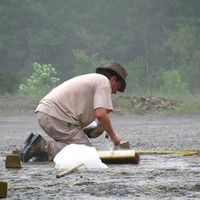Papers by katerine rodriguez
Soil Science, Jan 1, 1980
In a stand of Fagus silvatica in the Solling highlands, Federal Republic of Germany, we followed ... more In a stand of Fagus silvatica in the Solling highlands, Federal Republic of Germany, we followed the effect of acid precipitation on chemical soil state and the ion fluxes in the ecosystem between 1966 and 1979. As indicated by increasing aluminum concentration in the soil solution and an increase in organic matter storage in the forest floor, for example, the

Reviews of Geophysics, Jan 1, 1995
Loess is a wind-blown Quaternary silt deposit that blankets vast tracts of land and in places rea... more Loess is a wind-blown Quaternary silt deposit that blankets vast tracts of land and in places reaches thicknesses in excess of 300 m. Over the last decade it has emerged that certain loess sections have recorded the polarity history of the geomagnetic field and now provide essentially continuous magnetostratigraphic archives covering the last 2–3 m.y. Indeed, it is the chronology provided by the magnetic polarity signature itself that was largely responsible for establishing the timing of the initiation of loess accumulation, particularly in the celebrated Chinese loess plateau, where a starting date close to the Gauss-Matuyama chron boundary (2.6 Ma) is now firmly established. This coincides with a widely documented global climatic shift and accelerated uplift of the Tibetan plateau. Many loess sections contain fossil soils (paleosols) that bear witness to warmer and wetter climatic conditions corresponding to interglacial periods in contrast to the cold, arid environments in which pristine loess accumulated and which correspond to glacial intervals. The resulting sequences of alternating loess and paleosols also manifest themselves magnetically, in this case in terms of susceptibility changes, entirely distinct from the remanence characteristics, which encode the geomagnetic polarity. The susceptibility time series obtained from localities in Alaska and China correlate remarkably well with the oceanic oxygen isotope signal and yield spectral power estimates in agreement with those predicted by the astronomical (Milankovitch) theory of ice ages. Comparison of susceptibility patterns with corresponding profiles of 10Be concentration in loess allows major changes in rainfall to be estimated. In China, for example, data spanning the last 130 kyr (corresponding to oxygen isotope stages 1–5) indicate that paleoprecipitation was almost halved (from ∼540 to ∼310 mm yr−1) as the warm interglacial during which paleosol S1 formed gave way to the following glacial interval in which loess layer L1 accumulated. It has also been found that increased amounts of continent-derived dust delivered to the deep ocean correlate with loess formation and thereby permit certain broad features of atmospheric circulation (paleowinds) to be worked out. Debate continues over the actual mechanism by which magnetic susceptibility becomes a climate proxy. The current consensus is that some form of in situ process must be responsible, at least in part. Detailed laboratory investigations, both on whole samples and on magnetic extracts, indicate that the enhancement observed in midlatitude weathered loess and paleosols is largely due to a magnetically “soft” mineral which is either magnetite (Fe3O4) or maghemite (γ-Fe2O3). Experimental evidence is accumulating that tiny (<100 nm) ferromagnetic particles probably generated by the activity of magnetotactic bacteria in the soil are responsible.
Geology, Jan 1, 1991
The user has requested enhancement of the downloaded file.

Geophysical Journal of The Royal Astronomical Society, Jan 1, 1984
The age of Chinese loess deposits has long been disputed. Biostratigraphical and earlier magnetos... more The age of Chinese loess deposits has long been disputed. Biostratigraphical and earlier magnetostratigraphical investigations placed the entire loess formation within the Pleistocene and ascertained a maximum loess age of about 1.2 Myr. A new collection of nearly 500 samples from a natural outcrop and a borehole section near Lochuan (lat. 35.8°N, long. 109.2°E; Shaanxi province) has been dated by magnetic stratigraphy. Thermal cleaning of the natural remanent magnetization (NRM) removes a strong secondary component of viscous origin along the present geomagnetic field which resides largely in magnetite. The characteristic NRM component is due to haematite which is thought to be of chemical origin. Rhythmical intensity variations of NRM and initial susceptibility depend on the loess lithology and may reflect climatic changes during loess deposition.The palaeomagnetic results are consistent between the two sections and yield a clearly defined magnetic polarity zonation. The Brunhes-Matuyama boundary and the Jaramillo subchron have been positively identified in both outcrops at exactly the same stratigraphic level. The Olduvai subchron has been found in the borehole section which records the entire loess sequence. Most probably the formation of Chinese loess began shortly after the Matuyama-Gauss polarity transition. Therefore a late Pliocene age of about 2.4 Myr is assigned to the oldest loess sediments measured.

Quaternary Science Reviews, Jan 1, 1987
The loess deposits in central China record world-wide climate changes of the last 2.5 Ma. Numerou... more The loess deposits in central China record world-wide climate changes of the last 2.5 Ma. Numerous climatic oscillations are marked by alternating loess and soil units with continuous coverage of the Matuyama and Brunhes Epochs. Magnetic susceptibility of the deposits correlates closely with the oxygen isotope record of the deep-sea sediments and provides an independent measure of climate and time.The key marker bed of the chinese loess sequence is the paleosol S5, the time equivalent of the mid-Brunhes oxygen isotope stages 13, 14 and 15. It marks a prolonged interval of warm humid climate lasting from approximately 615 to 470 thousand years ago. Several episodes of river downcutting coincide with deposition of the exceptionally thick loess units L1 (oceanic oxygen isotope stages 2 to 4) L2 (stage 6), L5 (stage 12) L6, (stage 16) L9 (stage 22) L15 (stage 38 about 1.15 Ma) and WS4 (about 2.3 Ma). These erosional events are interpreted as a result of episodic uplift of the Loess Plateau.The deposition of the earliest loess layers between 2.5 and 2.3 Ma ago marks a first order shift from warm and humid environments toward harsh continental steppes comparable to those of the Middle and Late Pleistocene. Little, if any lithologic or paleontologic changes were noted within or above the Olduvai magnetozone, so that the proposed Plio/Pleistocene boundary at approximately 1.65 Ma has no lithostratigraphic and biostratigraphic representation in the chinese loess series.Comparison with the Deep Sea Drilling Program core 552A in the North Atlantic and with the Santerno River section near Bologna shows that the occurrence of the earliest loess in China coincides with the timing of the first significant ice rafting in the North Atlantic and with the appearance of cold water foraminifers in the marine deposits of northern Italy. An extension of the stage system of the oxygen isotope signal extended back to the Gauss-Matuyama boundary is proposed.
Soil Science, Jan 1, 1975
Abstract The number of earthworm channels ranging from 2 to 11 mm in diameter were counted to 80 ... more Abstract The number of earthworm channels ranging from 2 to 11 mm in diameter were counted to 80 cm depth in tilled and untilled grey-brown podzolic soil derived from loess. Number and percentage volume of earthworm channels in the Ap horizon approximately ...

Palaeogeography Palaeoclimatology Palaeoecology, Jan 1, 1989
Loess sequences in central China provide a detailed record of climate changes during the last 2.5... more Loess sequences in central China provide a detailed record of climate changes during the last 2.5 million years. At least 44 major shifts from glacial to interglacial conditions occurred during this time in China. Prolonged loess deposition lasting more than 40 millennia occurred eleven times with only four of these intervals in Brunhes Chron. The climate oscillations took place with increased frequency between 2.4 and 0.5 Ma compared to the last half million years. Major shifts toward cooler and drier climates occurred at about 2.4 Ma, 1.2 Ma, and 0.5 Ma, while less pronounced shifts are dated to 1.65 Ma, 0.8 Ma and 0.2 Ma. Three of the last four reversals of the earth's magnetic field whose lithostratigraphic position has been detail, are recorded in a glacial deposit.The low field magnetic susceptibility of loess and soils which reflects the concentration of ultrafine magnetite is related to the degree of pedogenesis and serves as a proxy measure of climate. The accumulation rate of the magnetite was fairly constant throughout the last 1.2 million years and can serve as a measure of time. Susceptibility records from localities near Xifeng and Luochuan, located 160 km apart are compared and used to define informal lithostratigraphic units in the Loess Plateau of China.










Uploads
Papers by katerine rodriguez